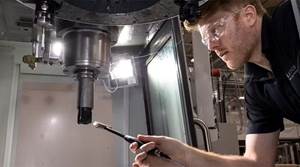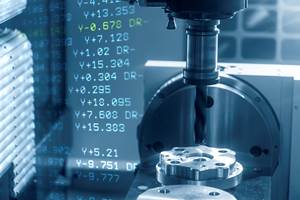Slashing Part-To-Part Programming Time On The Shop Floor
How do you improve productivity with the excessive amount of time and effort it takes to program parts before they can be run on the shop floor? As parts have become more complex over the years and demands for accuracy have become more stringent, the challenge has become even greater. Shop owners are faced with the dilemma of being even more productive, while still spending hours programming machinery before cutting their first parts. Now there is an option for shop owners that enables them to go from part to part on the shop floor without involving off-line programmers.
Share





How do you improve productivity with the excessive amount of time and effort it takes to program parts before they can be run on the shop floor? As parts have become more complex over the years and demands for accuracy have become more stringent, the challenge has become even greater. Shop owners are faced with the dilemma of being even more productive, while still spending hours programming machinery before cutting their first parts.
Now there is an option for shop owners that enables them to go from part to part on the shop floor without involving off-line programmers. In a fraction of the time it takes to generate G-code and do trigonometric calculations, a DXF file translator, available on Hurco's Ultimax CNC, enables much of the program optimizing traditionally done off-line to be efficiently performed at the machine.
In creating the CNC, Hurco recognized the complicated challenges of part programming and set about making a system that would put more control back into the hands of machinists on the shop floor. Being close at hand allows them to easily adapt to changes as they take place in real time. The control's unique dual screen allows machinists to program parts with text on one screen and graphics on the other. It eliminates the need to toggle between two screens, possibly losing track of valuable data.
Conversational programming has changed shopfloor programming. In the past when part information came in—say, on a blueprint—it went to a programmer who worked with a CAM system. The programmer then worked out the G-code and brought everything for the machinist to be entered at the machine tool control. This entire process, even for a simple part, could take ninety minutes or two hours or even longer. Both the programmer and the machinist had to know computer programming, and both had to be able to perform fairly sophisticated trigonometric calculations to create the appropriate arcs and lines for the tool path.
The result of conversational programming is a dramatic productivity increase. The system was devised as a simple, fill-in-the-blanks format. Machinists can simply take dimensions and part information directly from the blueprint, enter it at the control, and the job is ready to go. Even complex trigonometric calculations are performed automatically.
Not only does the machinist not spend weeks learning computer programming, conversational programming also eliminates the need for back room data manipulation. Conversational programming makes it possible to go from print to part in a matter of 10 or 15 minutes, with a single machinist, on the shop floor.
Today, however, many shops receive part information electronically, either on floppy disk or over the Internet. Without a blueprint to read, the same problem potentially arises: the CAD file has to be taken to a CAM system, where it's prepared for the machinist. That's where the DXF file translation comes in to play. DXF is essentially an electronic blueprint. It's a file format generated by AutoCAD and other CAD systems.
With the Ultimax DXF option, these files can be loaded directly into the CNC from a disk or hard drive. Once the DXF file is loaded into the system, the CAD data is converted directly to conversational programming data blocks. Now the machinist has to enter virtually no data at all, it's all entered automatically.
Complex geometry such as contours, that used to require hours of manual programming time, can be done in a couple of minutes. The machinist can point and click on the first element of each contour, and it's "auto-chained" into the program. Similarly, the machinist can point and click each part feature—holes, frames, circles, and more—to create program data blocks, again, without manually entering reams of data. Then all that's left is to enter tool data and surface speed. In all, programming a complex part with this option takes four or five minutes.
With this system, the machinist is in control of his or her own productivity on the shop floor. The machinist has the autonomy to choose the right tooling, choose the zero point, and make other machining decisions, in real time, without having to hassle with programming and calculations.
The machinist can also program the next part at the control while the first part is running. Essentially, even minutes of unproductive programming time are reduced to no time at all. The demands for productivity on the shop floor are greater today than they ever have been. By giving the machinist tools such as conversational programming and DXF compatibility, a shop owner is in a better position to respond to such challenges as just-in-time production and delivery. That is the true bottom line: putting productivity tools in the hands of machinists is ultimately the way to a more profitable higher quality operation.
Related Content
Orthopedic Event Discusses Manufacturing Strategies
At the seminar, representatives from multiple companies discussed strategies for making orthopedic devices accurately and efficiently.
Read MoreHow to Mitigate Chatter to Boost Machining Rates
There are usually better solutions to chatter than just reducing the feed rate. Through vibration analysis, the chatter problem can be solved, enabling much higher metal removal rates, better quality and longer tool life.
Read More6 Machine Shop Essentials to Stay Competitive
If you want to streamline production and be competitive in the industry, you will need far more than a standard three-axis CNC mill or two-axis CNC lathe and a few measuring tools.
Read MoreTips for Designing CNC Programs That Help Operators
The way a G-code program is formatted directly affects the productivity of the CNC people who use them. Design CNC programs that make CNC setup people and operators’ jobs easier.
Read MoreRead Next
Machine Shop MBA
Making Chips and 91ÊÓƵÍøÕ¾ÎÛ are teaming up for a new podcast series called Machine Shop MBA—designed to help manufacturers measure their success against the industry’s best. Through the lens of the Top Shops benchmarking program, the series explores the KPIs that set high-performing shops apart, from machine utilization and first-pass yield to employee engagement and revenue per employee.
Read MoreAMRs Are Moving Into Manufacturing: 4 Considerations for Implementation
AMRs can provide a flexible, easy-to-use automation platform so long as manufacturers choose a suitable task and prepare their facilities.
Read MoreLast Chance! 2025 Top Shops Benchmarking Survey Still Open Through April 30
Don’t miss out! 91ÊÓƵÍøÕ¾ÎÛ's Top Shops Benchmarking Survey is still open — but not for long. This is your last chance to a receive free, customized benchmarking report that includes actionable feedback across several shopfloor and business metrics.
Read More





















